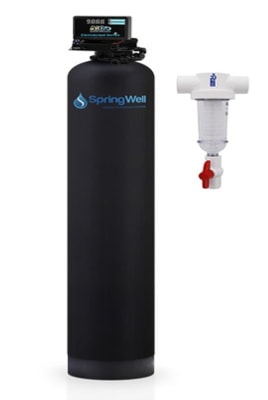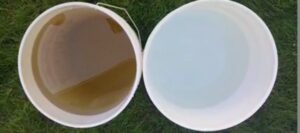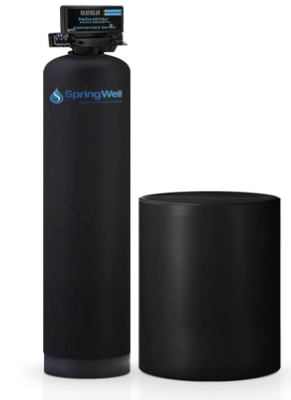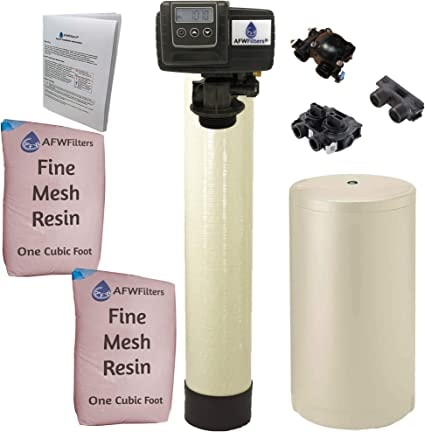Impurities in well water can change its color. Brown well water is a common problem private well owners face. Colored water is undrinkable and unfit to use.
Reasons behind Brown Well Water and Their Solutions
Your well water can get reddish-brown due to the following reasons.
Iron
Iron is the most common culprit behind brown water. There are three different types of iron found in well water, and each one can give a different shade of brown. They are listed below.
- Iron bacteria, it gives a reddish color and appears as slime. It is usually present in toilet tanks.
- Ferric iron, also known as red iron and makes the water cloudy and orange-brown
- Ferrous iron, it is colorless when water flows out of the tap but turns brown/orange after water stands for some time. It imparts a metallic taste and leaves stains on laundry and crockery.
The safe limit mentioned by EPA is 0.3mg/L. If the water tests indicate a higher limit than this, you must install an iron filter urgently.
Solution – The most effective way to remove iron from well water is to use a whole house iron filter. We recommend SpringWell’s Whole House Well Water Filter System that can remove up to 7 PPM iron, 8 PPM hydrogen sulfide, and 1 PPM manganese. You can also customize the system to add a sediment filter, water softener (salt-based or salt-free), and a UV purifier to remove microorganisms.
The filter uses air oxidizing technology to remove these contaminants from your water and make it usable. It is easy to install, doesn’t require frequent maintenance, and is covered by a lifetime warranty.

Rust

Water may get brown due to rust particles in water pipes. It usually happens in old homes with copper pipes. It is possible that only a few taps will have brown water. This indicates that not all pipes are rusted.
Solution – The immediate solution to this problem would be to stop using such taps. However, you cannot carry on like this for long. You will need to replace the rusted water pipes as soon as possible.
Well Infrastructure
A damaged well casing or screen can also lead to brown well water. It creates way for dust, sand, silt, gravel to enter your well.
Solution – Get your well inspected for any damages and start repairs. A damaged well can also create other problems.
Tannins

Tannin is a yellowish or brownish bitter-tasting organic substance present in galls, barks, and plant tissues. The tannin problem is more common with shallow wells and happens during the autumn season due to excessive leaves around the well. Tannins will not harm your health but can leave stains on clothes, floors, and crockery.
Solution – Tannins can be pretty hard to remove at times. However, you don’t need to worry, as SpringWell’s Tannin Removal System will remove up to 99% tannin from your well water. This system comes in handy when your well is located under a tree or has an inherent tannin contamination. Moreover, the unit also removes hardness from your well water. All of this comes in a single tank configuration, saving space and having less impact on the environment.
You can also rake the area near well to clear the tannins and tree debris. Well experts suggest that you must keep the area near your well neat and clean. It helps in improving water quality and increasing well life.

Silt
Silt, dust, sand, and other organic waste can make your water look brown. Suspended particles in water are usually not harmful but look irritating. They can also change the taste of your beverages.
Solution – A sediment filter will remove all the suspended particles from the water and remove the brown color from your water.
Well water got gray suddenly? Click here to find out more about it!
Brown Color in Hot Water Taps
It is also possible that only the hot water taps give brown-colored water. In such a situation, the issue is with your water heater and not your home’s entire plumbing system.
Solution – Get your water heater serviced or flush it. It will clear the rust and iron deposit inside the heater.
Can’t find the Problem?
If you have tried everything and can’t locate the reason for brown well water, it is time to get it tested. EPA recommends that every well owner must get their water tested annually.
Some other ways to remove Brown Color from Well Water
You can also use the following ways to remove iron and the brown color caused by it.
Greensand – A greensand filter uses potassium permanganate to remove iron from raw water. Sometimes a mixture of chlorine and potassium permanganate is also used in some filters. The soluble iron is oxidized into insoluble form and then removed by the filtration bed.
Ion exchange – Some water softeners are capable of removing iron from water. AFWFilters Iron Pro 2 combination water softener and iron filter is reliable for removing iron up to 6 PPM. Please note that salt-less water softeners will not remove iron from water. 
However, using water softeners to remove iron increases maintenance, salt replacement and may also impact the overall performance of the system.
Aeration – Aeration is also used to treat well water. Aeration uses dissolved oxygen to oxidize several compounds such as iron, manganese, ammonium, and organic substances. Aeration also removes gases such as carbon dioxide, carbon monoxide, and hydrogen sulfide.
FAQ
Is brown well water safe to drink?
No. You must not drink brown water. The iron bacteria is generally harmless but it can harbor disease causing microorganisms.
Which is the best water filter to remove iron from well water?
SpringWell’s iron filter is is one of the best water filters for water well to remove iron and hardness. Apart from iron and hardness, it will also remove manganese, sediment sand, and rust from well water.
Final Words – What’s the best setup?
You don’t only have to clear the iron in well water; you have to make sure that all the other contaminants are removed by your filter as well. This is only possible when you test your water annually and then install/upgrade the water treatment system.
